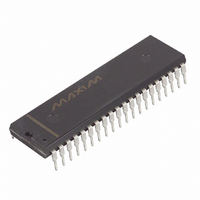DS80C323-MCD+ Maxim Integrated Products, DS80C323-MCD+ Datasheet - Page 18

DS80C323-MCD+
Manufacturer Part Number
DS80C323-MCD+
Description
IC MCU HI SPEED 18MHZ 40-DIP
Manufacturer
Maxim Integrated Products
Series
80Cr
Datasheet
1.DS80C323-QND.pdf
(38 pages)
Specifications of DS80C323-MCD+
Core Processor
8051
Core Size
8-Bit
Speed
18MHz
Connectivity
EBI/EMI, SIO, UART/USART
Peripherals
Power-Fail Reset, WDT
Number Of I /o
32
Program Memory Type
ROMless
Ram Size
256 x 8
Voltage - Supply (vcc/vdd)
4.5 V ~ 5.5 V
Oscillator Type
External
Operating Temperature
0°C ~ 70°C
Package / Case
40-DIP (0.600", 15.24mm)
Processor Series
80C
Core
8051
Data Bus Width
8 bit
Program Memory Size
64 KB
Data Ram Size
64 KB
Interface Type
UART
Maximum Clock Frequency
18 MHz
Number Of Programmable I/os
32
Number Of Timers
3
Operating Supply Voltage
5 V
Maximum Operating Temperature
+ 70 C
Mounting Style
Through Hole
3rd Party Development Tools
PK51, CA51, A51, ULINK2
Minimum Operating Temperature
0 C
Controller Family/series
(8051) 8052
No. Of I/o's
32
Ram Memory Size
256Byte
Cpu Speed
18MHz
No. Of Timers
3
Embedded Interface Type
UART
Rohs Compliant
Yes
Package
40PDIP
Device Core
8051
Family Name
80C
Maximum Speed
18 MHz
Lead Free Status / RoHS Status
Lead free / RoHS Compliant
Eeprom Size
-
Program Memory Size
-
Data Converters
-
Lead Free Status / Rohs Status
Lead free / RoHS Compliant
DS80C320/DS80C323 High-Speed/Low-Power Microcontrollers
immediately preceding the setting of the Stop bit to guarantee a correct power-on delay when exiting Stop
mode.
The second feature allows an additional power saving option. This is the ability to start instantly when
exiting Stop mode. It is accomplished using an internal ring oscillator that can be used when exiting Stop
mode in response to an interrupt. The benefit of the ring oscillator is as follows.
Using Stop mode turns off the crystal oscillator and all internal clocks to save power. This requires that
the oscillator be restarted when exiting Stop mode. Actual start-up time is crystal dependent, but is
normally at least 4ms. A common recommendation is 10ms. In an application that will wakeup, perform a
short operation, then return to sleep, the crystal startup can be longer than the real transaction. However,
the ring oscillator will start instantly. The user can perform a simple operation and return to sleep before
the crystal has even stabilized. If the ring is used to start and the processor remains running, hardware will
automatically switch to the crystal once a power-on reset interval (65,536 clocks) has expired. This value
is used to guarantee stability even though power is not being cycled.
If the user returns to Stop mode prior to switching of crystal, then all clocks will be turned off again. The
ring oscillator runs at approximately 3MHz (1.5MHz at 3V) but will not be a precision value. No real-
time precision operations (including serial communication) should be conducted during this ring period.
Figure 4 shows how the operation would compare when using the ring, and when starting up normally.
The default state is to come out of Stop mode without using the ring oscillator.
This function is controlled using the RGSL - Ring Select bit at EXIF.1 (EXIF to 91h). When EXIF.1 is
set, the ring oscillator will be used to come out of Stop mode quickly. As mentioned above, the processor
will automatically switch from the ring (if enabled) to the crystal after a delay of 65,536 crystal clocks.
For a 3.57MHz crystal, this is approximately 18ms. The processor sets a flag called RGMD - Ring Mode
to tell software that the ring is being used. This bit at EXIF.2 will be logic 1 when the ring is in use. No
serial communication or precision timing should be attempted while this bit is set, since the operating
frequency is not precise.
18 of 38














